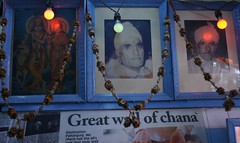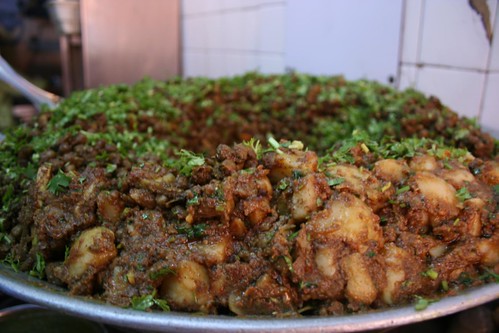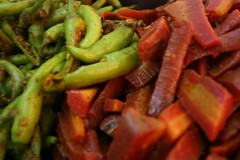When conniving Mughal upstart Aurangzeb imprisoned his father, Emperor Shah Jehan, in Agra Fort in 1657, he told him he could choose just one thing to eat every day for the rest of his life. The old man chose chick peas because the prison cook told him he would be able to make something different every day of the year.
Until recently, I would have snorted in disbelief at this – chick peas? Synonymous with hairy hippies in bedsits and tubs of slimy supermarket hummous? Then came Chana Bhatura and I discovered I could actively crave something involving chick peas.
There are very few deep-fried foods I can resist and I admit what first attracted me to this dish, in places like Evergreen in Green Park and Nathus in Bengali Market, were the magnificent balloon-sized puffed-up bhatura. In the early days the accompanying chana was just a sloppy, sludge-coloured distraction. I used to dip the bread but I’m ashamed to admit the chick peas often went back to the kitchen barely touched.

It’s hard to say how things changed, all I know is before long the bhatura was merely the vehicle for scooping ever more of the soft, creamy, spicy peas.
I’m now more likely to eat at the kind of joint that offers ‘unlimited chana’. Like Sita Ram Dewan Chand in Paharganj, where Hemanshu and I headed last week in the latest leg of our mission to persuade Delhi’s finest street food joints to part with their secret family recipes.

From their small shop in Chuna Mandi near the Imperial Cinema, Sita Ram make what many Delhi-ites believe to be the perfect Chhole Bhature. Certainly many customers, including leading industrialists and movie stars, travel great distances for their daily fix.
When we arrived at about 9am, the two or three tables outside the tiny kerbside restaurant were already buzzing with customers on their way to work. We managed to put away a plate each in no time.
Every mouthful was memorable but particularly those where I managed to cram in paneer-laced bhatura, chick peas, onion and pickled carrot, all at the same time. I strongly urge everyone to do this sometime soon and take a moment to give thanks for what’s going on in your mouth. I bet those 8 years in Agra Fort just flew by.
We spoke to fellow diner, 72 year-old Gulshan Jaggi who has been coming to the shop since 1948, often several times a week, even though he no longer lives in the neighbourhood. He maintains the Chana Bhatura is as good now as it was then, “I have tasted Chana Bhatura all over Delhi,” he said. “But here the chana is unique, very delicious. They maintain the standards set down by their ancestors.”

After we’d polished off a third plate, Pran Kohli, the current owner, took us through the history. His grandfather, Diwan Chand, arrived in Delhi from what is now Pakistan at the time of Partition in 1947 with little more than his recipe for Chana Bhatura. For almost 30 years, he and his son Sita Ram pushed a handcart around Paharganj before moving into their present shop in Chuna Mandi.
Pran Kohli joined the business straight from school in 1984. and has done little to alter the winning formula handed down to him – if it’s not broke, don’t fix it, I say. The secret, he says, is to treat even the most humble ingredients with respect. “This is a cheap roadside dish, but we use good quality ingredients so it’s better than others. We don’t want to compromise.” The result is food infused with love and care; a perfect combination of flavours and textures which, like all of the best street food in India, is a world-class feast.
The Recipes

Chana
Soak 1kg chick peas overnight. In the morning, boil the chick peas in fresh water for 30 minutes then add 25g bicarbonate of soda (according to Pran Kohli this speeds up the softening of the chick peas and aids digestion)
Brown 300g chopped onion in oil or ghee. Add 200g yogurt, 200g chopped tomatoes and 1tsp turmeric. Cook on a low heat for about one hour until the mixture is a deep reddish colour. When the chick peas are ready, drain off the cooking water and mix with the tomato and onion gravy. Add 20g salt, 20g black pepper, 30g dried pomegranate powder (anardana) and 15g garam masala – Sita Ram Diwan Chand’s mix, which they make themselves, contains black pepper, cinnamon, cloves, nutmeg, mace, coriander, cumin and something called ‘sud’ which I haven’t found a translation of yet). Mix well and add 200g potatoes made as follows:
For 1 kg cooked potatoes, chop 200g onion and cook in oil with 200g chopped tomatoes and 1tsp turmeric to make a gravy then add 10g salt, 10g black pepper, 5g red chilli powder, 25g dried pomegranate powder and 20g garam masala. Cook the gravy until the masala is roasted.
Bhatura

Mix 1kg plain flour (maida) and 1tsp baking powder with approximately 400g water (enough to make a soft dough). Knead well for 7-10 minutes or until dough is soft and springy. Put in a bowl and leave, covered with damp tea towel for at least one and a half hours.
For the bhatura stuffing, finely chop 300g of paneer and add 10g salt, 5g cumin seeds, 5g garam masala, 5g black pepper, 10g chopped fresh coriander. Press a handful of stuffing into each small ball of dough before rolling out and frying.
Sita Ram Diwan Chand’s Chana Bhatura comes with slices of onion and pickled vegetables (carrot when we visited but varies according to the season) and both play an important part in creating a perfect combination of flavours.
Pickled Carrots

Wash and cut up 1kg of carrot into long chunks and steep for a few days in 2 litres of ‘sour water’ (water containing 25g black mustard seed, 10g salt, 5g turmeric). Wash the carrots, add 10g salt, 5g red chilli and mix well.
[This piece was originally published on Pamela’s personal blog. Photographs by Hemanshu Kumar]